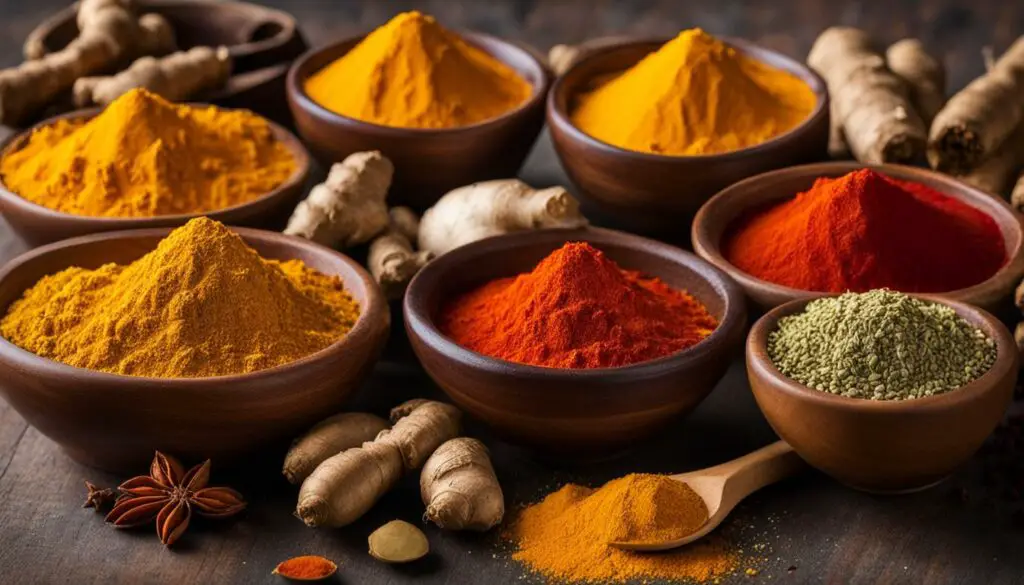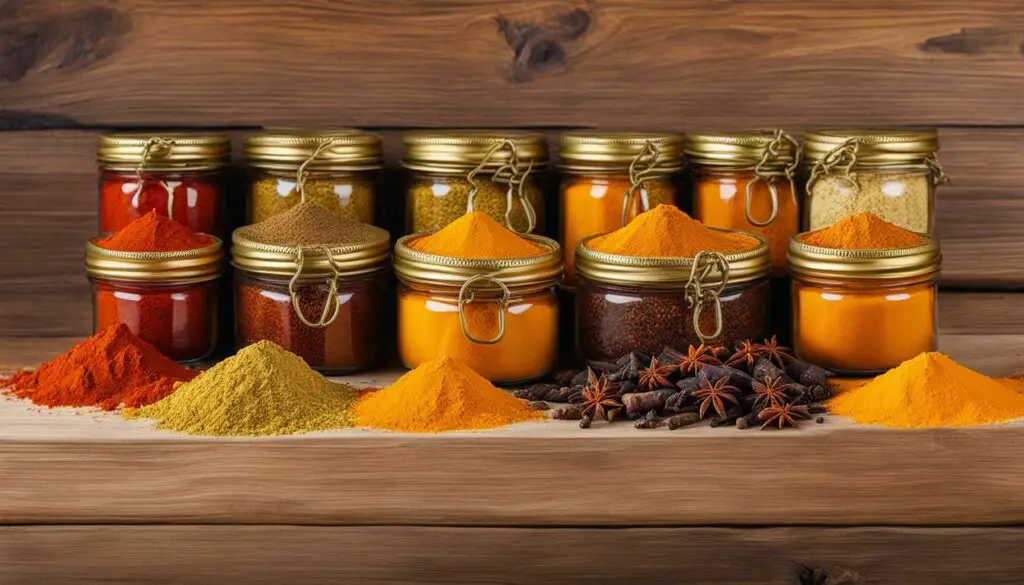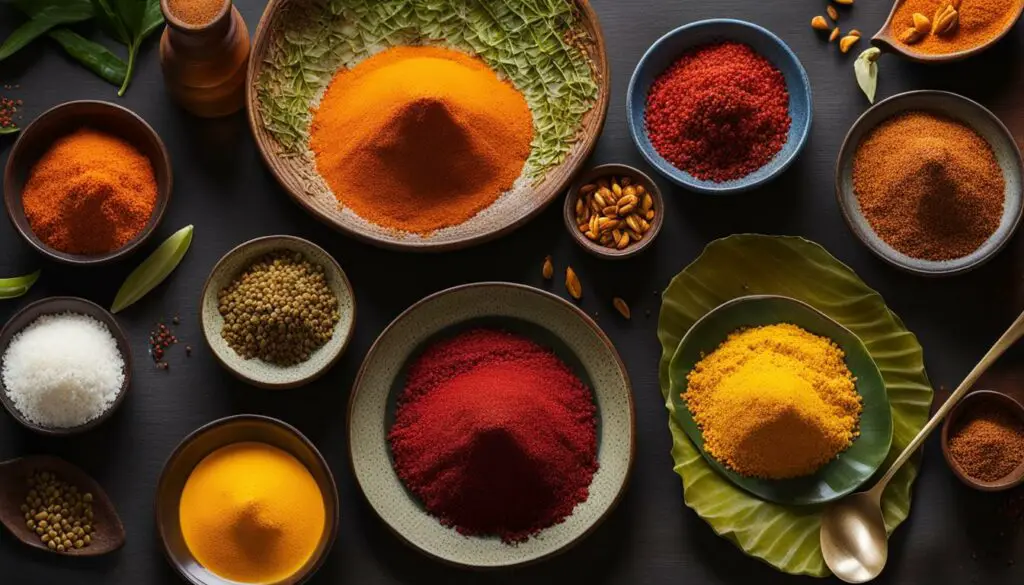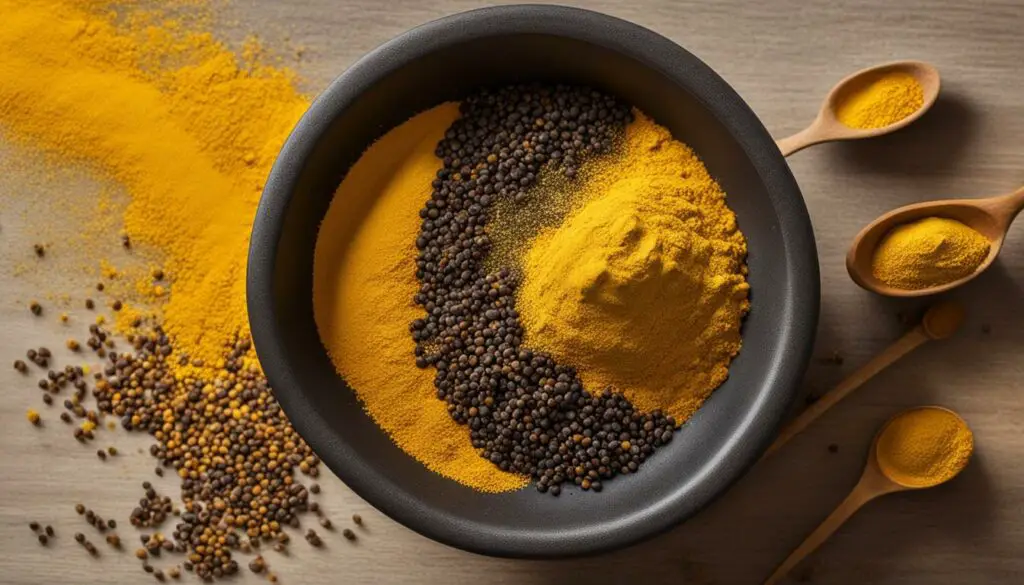Originally posted on November 18, 2023 @ 6:17 am
For many, turmeric is a staple spice in the kitchen. However, there may be times when you need to find a substitute for ground turmeric, whether it’s due to dietary restrictions or simply an unavailability of the spice. Fortunately, there are a variety of turmeric alternatives that can be used in cooking and provide a similar flavor profile to ground turmeric.
In this guide, we will explore some of the best substitutes for ground turmeric, including natural alternatives and other spices that can be used as replacements. These substitutes can be easily incorporated into your recipes and provide a unique twist to your dishes.
Table of Contents
Key Takeaways:
- There are various reasons why you may need to substitute ground turmeric in your recipes.
- There are several natural alternatives and other spices that can provide a similar flavor profile to ground turmeric.
- Some of the best turmeric substitutes include ginger, curry powder, saffron, paprika, cumin, annatto, mustard powder, and nutmeg.
- Experiment with different alternatives to find the perfect substitute for your recipes.
- Substitutes for ground turmeric can add a unique twist to your dishes and provide a range of health benefits.
Why Substitute Ground Turmeric?

There are several reasons why you might need to substitute ground turmeric in your recipes. It could be due to dietary restrictions, unavailability of turmeric, or simply wanting to try something new. Whatever the reason may be, there are plenty of non-turmeric spice alternatives that can be used in cooking.
“Substituting one ingredient for another can lead to exciting new flavors and culinary discoveries.”
Trying out new spices can also be an opportunity to experiment with flavors and expand your culinary horizons. While turmeric has many health benefits and is a staple in many kitchens, it’s not the only spice that can be used to add depth and complexity to your dishes.
In the next sections, we will explore some of the best turmeric substitutes in cooking, including natural alternatives and other spices that provide similar flavor profiles.
Turmeric Alternatives: Ginger
Ginger is a natural turmeric substitute that has been used in cooking for centuries. It has a warm, earthy flavor with a hint of spiciness that makes it a great replacement for ground turmeric in recipes. Ginger also has numerous health benefits, including anti-inflammatory and antioxidant properties.
To use ginger as a turmeric substitute in recipes, you can grate fresh ginger root or use ground ginger powder. Here are some tips for using ginger in specific dishes:
Ginger and Lemon Tea
To make a soothing ginger and lemon tea, add a few slices of fresh ginger and a squeeze of lemon to hot water. This tea can help ease digestive issues and boost the immune system.
Ginger Chicken Stir Fry
For a flavorful ginger chicken stir fry, marinate chicken in soy sauce, ginger, garlic, and sesame oil. Then stir fry with vegetables and serve over rice.
Ginger Carrot Soup
Add grated ginger to carrot soup for an added layer of flavor. Blend cooked carrots with vegetable broth, ginger, garlic, onion, and coconut milk for a creamy and delicious soup.
Overall, ginger is a versatile and natural turmeric substitute that can be used in a variety of recipes. Try incorporating ginger into your cooking for a flavorful and healthy twist!
Turmeric Alternatives: Curry Powder

Curry powder is a blend of various spices, including turmeric. If you are looking for a replacement for ground turmeric, curry powder can offer a similar flavor profile. However, keep in mind that curry powder is not a one-to-one substitute for ground turmeric and may alter the taste of your recipe.
When using curry powder as a turmeric substitute in cooking, start with a small amount and gradually add more if needed. This will help you maintain the intended flavor and prevent the dish from becoming too spicy or overpowering.
| Turmeric | Curry Powder |
|---|---|
| Earthy and slightly bitter flavor | Spicy and complex flavor with hints of turmeric |
| Distinctive yellow color | Dark yellow to brown color |
As you can see from the table above, curry powder has a darker color compared to ground turmeric. If color is important to your recipe, you may need to adjust the quantity of other ingredients to maintain the desired hue.
Curry powder can be used in a variety of dishes, including soups, stews, and curries. It also works well as a seasoning for roasted vegetables or grilled meats.
Overall, curry powder is a viable turmeric substitute in cooking, especially if you enjoy a more complex and spicy flavor profile. Experiment with different quantities and find the right balance for your recipe.
Turmeric Alternatives: Saffron

If you’re looking for a natural substitute for ground turmeric, saffron is a great option. This spice is derived from the saffron crocus flower and has a unique flavor that can enhance various dishes.
When using saffron as a turmeric substitute in cooking, keep in mind that it has a higher price point and a more pungent flavor. It’s also known for its vibrant yellow color, making it an excellent replacement in dishes where color is important.
To use saffron as a substitute for ground turmeric, follow these steps:
- In a small bowl, add a few saffron strands.
- Pour hot water or broth over the saffron and let it steep for at least 10 minutes.
- Use the saffron-infused liquid as a replacement for ground turmeric in your recipe, adjusting the quantity as needed to achieve the desired flavor and color.
Turmeric Alternatives: Paprika

If you’re looking for an earthy and mildly spicy substitute for ground turmeric, paprika could be a great option. This reddish-brown spice comes from grinding dried peppers and has a smoky, slightly sweet flavor that can complement a wide range of dishes.
When using paprika as a replacement for turmeric, keep in mind that it won’t provide the same vibrant yellow color. However, it can still add a subtle hue to your dish. If color is important, you can add a pinch of saffron or mustard powder to achieve a similar golden hue.
| Turmeric | Paprika |
|---|---|
| Provides a bright yellow color to dishes | Provides a reddish-brown color to dishes |
| Has a warm, slightly bitter flavor | Has a smoky, slightly sweet flavor |
| Can be used in curries, soups, and stews | Can be used in meat dishes, roasted vegetables, and sauces |
Ultimately, whether you choose to substitute paprika for turmeric will depend on the dish you’re making and your personal taste preferences. Experiment with different spices to find the perfect replacement for your recipe.
Turmeric Alternatives: Cumin

If you’re looking for a spice that can add an earthy and slightly nutty flavor to your dishes, cumin may be a great substitute for ground turmeric. With its warm and pungent taste, cumin can complement and enhance the flavors of many dishes, making it a popular choice in various world cuisines.
To use cumin as a turmeric substitute in cooking, start by replacing it in equal quantities. Keep in mind that cumin has a stronger flavor than turmeric, so you may want to adjust the amount based on your personal preference. You can also combine cumin with other spices such as coriander, cinnamon, or paprika to create a unique flavor profile for your dish.
When using cumin as a substitute in recipes that require ground turmeric, keep in mind that it may not add the same vibrant yellow color to your dishes as turmeric would. You can compensate for this by using other natural food coloring options such as saffron or annatto.
Ways to use Cumin as a Turmeric Substitute
If you’re not sure how to incorporate cumin into your dishes as a turmeric substitute, here are some ideas:
- Use cumin to season roasted vegetables or meat dishes, such as chicken or lamb.
- Combine cumin with other spices to create a flavorful rub for grilled meats.
- Add cumin to soups and stews to enhance their flavor profile.
- Use cumin in spice blends for Mexican, Middle Eastern, or Indian dishes.
- Sprinkle cumin over hummus or other dips to add an extra layer of flavor.
Overall, cumin is a versatile spice that can be used as a substitute for ground turmeric in many different dishes. Experiment with different spice combinations and amounts to find the perfect flavor profile for your recipe!
Turmeric Alternatives: Annatto

Annatto is a natural food coloring derived from the seeds of the achiote tree. It has a slightly sweet and nutty flavor and can be used in place of ground turmeric in certain recipes. Annatto is a common ingredient in Latin American and Caribbean cuisine, adding a vibrant yellow-orange color to dishes such as rice, stews, and sauces.
To use annatto as a substitute for ground turmeric, you can either use the seeds or the powder form. The seeds can be infused in hot oil or water to extract the color and flavor and then removed from the dish before serving. The powder can be added directly to the dish, but be careful as it can stain clothing and surfaces.
Annatto has been used for centuries as a natural dye for textiles and food, and is considered a safe and healthy alternative to synthetic food colorings. It is also a good source of antioxidants and can provide several health benefits, including improved digestion and enhanced immune system function.
Annatto vs. Turmeric
| Annatto | Turmeric |
|---|---|
| Derived from achiote tree seeds | Derived from turmeric root |
| Slightly sweet and nutty flavor | Mild earthy flavor with a hint of bitterness |
| Provides a vibrant yellow-orange color | Provides a bright yellow color |
| Commonly used in Latin American and Caribbean cuisine | Commonly used in Indian, Middle Eastern, and Southeast Asian cuisine |
While annatto and turmeric share some similarities, they also have distinct flavor profiles and color contributions. Annatto can be a great substitute for turmeric in dishes where a vibrant color is desired, such as rice, soups, and sauces.
- Annatto is a natural food coloring derived from the seeds of the achiote tree.
- It has a slightly sweet and nutty flavor and can be used in place of ground turmeric in certain recipes.
- Annatto is a common ingredient in Latin American and Caribbean cuisine, adding a vibrant yellow-orange color to dishes such as rice, stews, and sauces.
- Annatto can be a great substitute for turmeric in dishes where a vibrant color is desired, such as rice, soups, and sauces.
Next, we will explore how mustard powder can be used as a substitute for ground turmeric in your recipes.
Turmeric Alternatives: Mustard Powder

If you are looking for a turmeric substitute in your cooking, mustard powder may be a good option to consider. Its pungent flavor profile can mimic the earthy taste of ground turmeric, making it a suitable replacement in dishes that call for this spice.
Mustard powder is made by grinding mustard seeds, which are commonly used in many cuisines around the world. It is a common ingredient in spice blends, such as curry powder and garam masala, which can also be used as substitutes for ground turmeric.
When using mustard powder as a turmeric replacement, start by adding a small amount and adjust according to your taste preferences. Remember that mustard powder has a stronger flavor than turmeric, so a little goes a long way.
| Turmeric | Mustard Powder |
|---|---|
| Earthy flavor | Pungent flavor |
| Yellow color | Yellow color |
| Anti-inflammatory properties | May have anti-inflammatory properties |
As shown in the table above, mustard powder and turmeric share a similar yellow color, but mustard powder has a stronger taste. While turmeric has well-known anti-inflammatory properties, research suggests that mustard powder may also have some anti-inflammatory benefits.
Overall, mustard powder can be a suitable substitute for ground turmeric in certain dishes. It is important to use it in moderation and adjust the quantity based on your personal preference. Give it a try and see how it works in your favorite recipes!
Turmeric Alternatives: Nutmeg
If you’re looking for a natural turmeric substitute in your cooking, nutmeg is an excellent option. This warm spice has a slightly sweet and nutty flavor that can add a unique touch to your dishes. It works particularly well in desserts and baked goods, where the earthy flavor of ground turmeric may be too overpowering.
To use nutmeg as a turmeric replacement, start by using a small amount and gradually increase it until you achieve the desired flavor profile. As with all spices, it’s essential to taste as you go to ensure that you get the best results. You can also experiment by combining nutmeg with other spices and herbs to create your custom blend.
Nutmeg VS Ground Turmeric
When it comes to flavor, nutmeg and ground turmeric are vastly different. While turmeric has an earthy and slightly bitter taste, nutmeg is nutty and slightly sweet. However, they both share a warm, woody aroma that can be incorporated into various dishes.
In terms of health benefits, nutmeg is an excellent source of antioxidants and has anti-inflammatory properties that can help reduce pain and swelling. It can also improve digestion and promote healthy blood circulation.
On the other hand, ground turmeric is well-known for its anti-inflammatory and antioxidant properties. It has been shown to have a positive effect on brain function and may help reduce the risk of heart disease.
| Nutmeg | Ground Turmeric |
|---|---|
| Nutty and slightly sweet flavor | Earthy and slightly bitter flavor |
| Excellent source of antioxidants | Anti-inflammatory and antioxidant properties |
| Anti-inflammatory properties | Positive effect on brain function |
| Can improve digestion | May help reduce the risk of heart disease |
Overall, while nutmeg and ground turmeric have different flavors and health benefits, they can both be used as substitutes in various recipes. Experiment with different spices and find the ones that work best for you.
Conclusion
Substituting ground turmeric in your recipes can be a challenge, but with the right knowledge and a bit of experimentation, you can achieve great results. This guide has provided you with a range of options, from natural alternatives like ginger and saffron to spice blends like curry powder and annatto.
Try Something New
Don’t be afraid to try something new and experiment with different spices and ingredients. You may discover combinations that you never thought possible, creating new and exciting flavors for your meals.
Keep an Open Mind
Remember to keep an open mind and be willing to adjust your recipes as needed. Some substitutes may require slightly different measurements or cooking techniques, but the effort is worth it when you find the perfect replacement for ground turmeric.
Enjoy the Flavors
Ultimately, cooking is all about enjoying the flavors and exploring new tastes. Whether you are substituting ground turmeric due to dietary restrictions or simply want to try something new, the alternatives discussed in this guide can help you achieve delicious and satisfying results.
So don’t be afraid to get creative and experiment with different spices and ingredients. The possibilities are endless, and the flavors are waiting to be discovered.
FAQ
Why would I need to substitute ground turmeric?
There are several reasons why you might need to substitute ground turmeric in your recipes. It could be due to dietary restrictions, unavailability of turmeric, or simply wanting to try something new. We will discuss alternative spices and ingredients that can be used as replacements in cooking.
What are some natural turmeric substitutes?
Some natural turmeric substitutes include ginger, saffron, and annatto. These spices can provide similar flavors and colors in your dishes. We will explore how to use these alternatives in various recipes.
Can I use curry powder instead of ground turmeric?
Yes, curry powder can be used as a replacement for ground turmeric. However, it is important to note that curry powder is a blend of various spices, including turmeric. We will provide tips on adjusting the quantity to maintain the desired flavor in your recipes.
How can I substitute ground turmeric with ginger?
Ginger is a popular substitute for ground turmeric as it shares a similar flavor profile and offers a hint of spiciness. You can use grated or ground ginger as a replacement in your recipes. We will explore how to incorporate ginger as a turmeric substitute in various dishes.
What dishes can I use saffron as a substitute for ground turmeric in?
Saffron can be used as a substitute for ground turmeric, particularly in dishes where color is important. It provides a vibrant hue and a unique flavor. We will discuss how to use saffron in place of turmeric in different recipes.
Can paprika be used as a substitute for ground turmeric?
Yes, paprika can be used as a substitute for ground turmeric. It has a similar color and earthy flavor that can complement various dishes. We will provide tips on incorporating paprika as a turmeric substitute in your recipes.
How can I use cumin as a substitute for ground turmeric?
Cumin is a popular spice with a distinct flavor that can complement and enhance the taste of various dishes. You can use cumin as a substitute for ground turmeric by adding it in smaller quantities and adjusting the other spices accordingly. We will explore how to incorporate cumin as a turmeric substitute in your recipes.
What is annatto and how can it be used as a turmeric replacement?
Annatto is a natural food coloring derived from a plant. It can provide a similar vibrant color to ground turmeric and be used as a substitute in certain dishes. We will discuss how to use annatto as a turmeric replacement in your recipes.
Can mustard powder be used as a substitute for ground turmeric?
Yes, mustard powder can be used as a substitute for ground turmeric. It has a pungent and slightly bitter flavor that can mimic the earthiness of turmeric. We will explore how mustard powder can be used as a turmeric substitute in recipes that call for turmeric.
How can nutmeg be used as a substitute for ground turmeric?
Nutmeg is a warm spice with a slightly sweet and nutty flavor. It can be used as a substitute for ground turmeric, particularly in desserts and baked goods. We will discuss how to incorporate nutmeg as a turmeric substitute in your recipes.
See also:
Leave a Reply